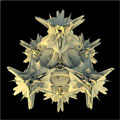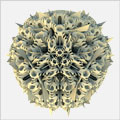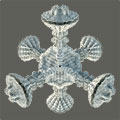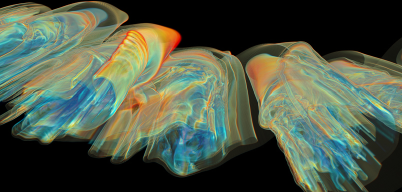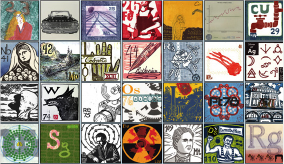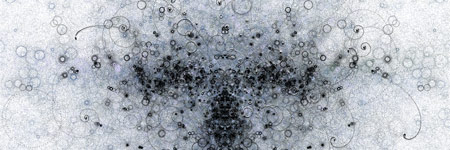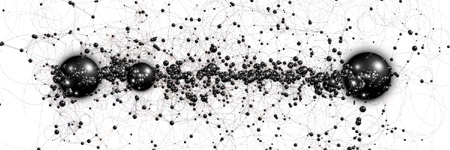We’ve all heard of generative graphics, how about generative architecture? The computational experiment Platonic Solids by Michael Hansmeyer is something you can get lost in for a good while. Especially since he’s added a 3-D anaglyph presentation. I hope you kept a pair of red-cyan 3D glasses in your junk drawer like I did!
Category Archives: Art
Art
Handheld Geometry
I’ve been reading The Symmetries of Things and came across the sculptor Bathsheba Grossman, an artist “exploring the region between art and mathematics.”
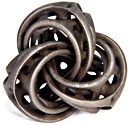 |
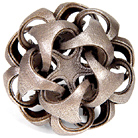 |
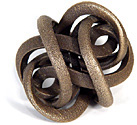 |
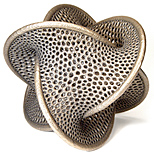 |
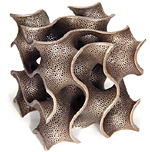 |
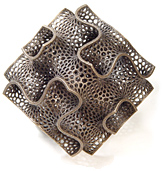 |
In addition to the artist’s site, here’s a ton of images available elsewhere, including the artist at work.
Visualizing Turbulence and Interpreting the Elements
I stumbled across two nice representations today. The first is a series of images visualizing turbulence. Some of these models took millions of processor hours to compute.
The second is a periodic table of the elements assembled out of 118 prints in various media. Sadly, no poster seems to be available just yet, but the project initiator hints that many things are in the works. Wouldn’t high school chemistry have been more fun this way?
Who Needs Dead Poets When You’ve Got Leonard Cohen?
I had the privilege to see Leonard Cohen perform at the Sony (formerly Hummingbird) Centre last night. Thanks to a buddy for the tickets. At $250 a pop I could never have afforded them. The show was… intensely moving. And yes, I know exactly how trite and tacky that sounds, but it’s the truth. I even wanted to leave the theatre for a moment to have a little cry at one point, but not because I was sad, just a little too emotional.
At this point, I ought to admit my relationship to Leonard Cohen is not that of a true devotee and that my perception and experience of him is somewhat distorted. Being Canadian, I grew up thinking of Leonard Cohen as a poet from the CanLit canon, since that’s the context in which I encountered him, i.e. being forced to study his poetry in high-school English class. I liked his poetry very much, even though I despised all the rest of the stodgy pillars of CanLit (excuse me, but Margaret Atwood can GET STUFFED!) Ahem. As I was saying… then it seemed to me that sometime around the 90’s he started putting out records and people started playing them all the time and I thought “Well, hell, that’s cool. Nobody reads poetry anymore anyway and kids certainly don’t. Smooth move, Mr. Cohen.” And then he became a singer/songwriter phenom and his words and music became part of the background of our lives….
Well, of course, I’m a complete idiot, because a little research will reveal that Cohen’s been a singer/songwriter since the 60’s. True, he’s published a quite a few books of poetry, and even a couple of novels, but music has always been his thing and I just never noticed. For the benefit of others who don’t know the man’s story any better than I do, he’s apparently had affairs with Janis Joplin and Rebecca DeMornay, among many others. He’s also an ordained Rinzai Zen Buddhist Monk, though he’s still a Jew (Zen is easy-going that way.) He’s also apparently broke due to a sordid betrayal, but you can go read about that yourself. An interesting life, to be sure.
So, back to the show. Leonard Cohen is about 75 years old. He hasn’t toured for 15 years. Rumour has it that this tour is an attempt to make back some of the money stolen from him, which accounts for the outrageous ticket prices. As soon as he appeared on the stage he received a standing ovation, and it wasn’t just an obligatory one, either; some of those people had been waiting for this moment for a decade and a half! He asked the crowd to be seated with a hand-gesture and then thanked everyone, with a shared chuckle, for the “financial inconvenience” they’d gone to in order to be present. Throughout the show, the man displayed exceeding humility, as well as joy and humour. He’s a fragile-looking guy, though his voice was strong and there was no lack of passion in his performance, especially in favourites like “Hallelujah”, “The Future”, and “Democracy” (which really ought to be an Obama campaign song, doncha think? Check the lyrics!) His pitch may have been a bit off, but then I’m not sure he was ever famous for being an incredible singer. Nobody cared anyway.
It’s the lyrics that make Leonard Cohen’s songs so amazing, and the audience was improbably silent throughout the show so as not to miss a word. This is especially important as Cohen changes the lyrics to his songs so you might hear something new even if you think you already know the piece by heart. He would often introduce the songs with snippets of the same song, or other songs, or bits and pieces of poetry (in English or in French.) At one point he recited a poem that, although it often repeats the phrase “A Thousand Kisses Deep”, bears no resemblance to the lyrics of the song of that name. I haven’t yet found where it came from, or if it’s new, or if he made it up just for the tour or what… I’m sure some avid fan will enlighten me.
Anyway, though he will be remembered as a singer/songwriter, Leonard Cohen is still primarily a poet to me. Last night I remembered why I loved his poetry as a teenager and why I ever loved poetry at all! It inspired me to go back and re-discover poetry all over again. I also left with a little remorse. For not having paid enough attention to his art in the past. For probably never having the chance to hear him perform again. He asked everyone to make sure on leaving the theatre to look in their hearts for–or re-find if necessary–the “blessings of peace”. It felt an awful lot like a final good-bye. And now I will have to go have that cry….
“In Rainbows” Album Art Competition
If you’ve downloaded the new Radiohead album and you’re craving some album art to go with those tunes on your iPod or iTunes (or whatever), my friend JTed has set up a Facebook group called “In Rainbows Album Art Competition.” Check out the entries. Add some of your own. Enjoy.
Artefacts of Computation
One of my favourite algorithmic artists is Jared Tarbell. He creates, among other things, visualizations of complexity. About his work, he writes:
I write computer programs to create graphic images.
With an algorithmic goal in mind, I manipulate the work by finely crafting the semantics of each program. Specific results are pursued, although occasionally surprising discoveries are made.
I believe all code is dead unless executing within the computer. For this reason I distribute the source code of my programs in modifiable form to encourage life and spread love. Opening one’s code is a beneficial practice for both the programmer and the community. I appreciate modifications and extensions of these algorithms. Please send me your experiences.
A couple of my favourite pieces include “Bubble Chamber” and “Node Garden”. You can watch each instance of the work evolve before your eyes, if your browser supports Java applets. The artist provides notes on design, process, and experiments, as well as source code (in Processing) anyone can play with.
Also see levitated.net.
The Art of Snow
It’s freakin’ cold outside, so might as well enjoy the view…
This image (click for full view and explanation) is actually part of the first annual Art of Science competition at Princeton University: “Celebrating the aesthetics of research and the ways in which science and engineering inform art.”
More Computational Sculpture
Yet another example of the aesthetics of mechanical computers, this time from Danny Hillis. The 10,000 Year Clock project was intended to “build a monument scale, multi-millennial, all mechanical clock as an icon to long term thinking.” Amusingly, it’s also billed as the world’s slowest computer. Here are a few teaser thumbnails. For detailed images and info, click below.
 |
 |
 |
 |
Slow Motion Landscape
My friend Mike Nowland has a show of his photography at the new Resistor Gallery on College St. @ Spadina. The opening was last week, but the work is still available for viewing. It’s gorgeous stuff. Here are a few teasers…
 |
 |
 |
 |
 |
 |
If you’re in the neighbourhood, you could just drop by weekdays after 9am. If you’re planning to go out of your way, it would be best to call or email first to make sure someone’s around.
Computers and Form
I love pictures of old machines in general, and mechanical computing devices in particular. Completely useless to us now, we can still admire them for their physical form. These photos of the Zuse Z1 (a reconstruction) were taken by my friend Gordon Hicks at the Deutches Technikmuseum Berlin. Click the thumbnails for more, full-size, photos.
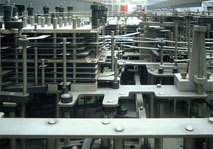 |
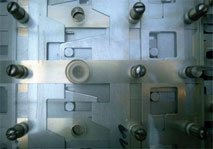 |

